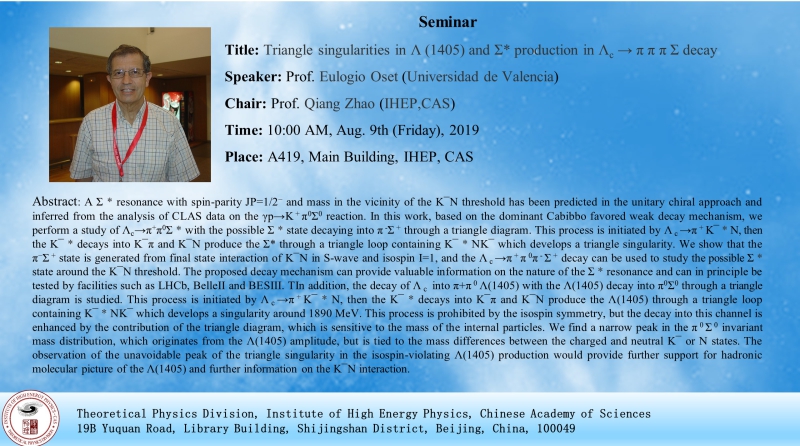| [8.9]Triangle singularities in Λ (1405) and Σ* production in Λc → π π π Σ decay |
| 文章来源: | 发布时间:2019-07-26 | 浏览:
|
|
Seminar Title: Triangle singularities in Λ (1405) and Σ* production in Λc → π π π Σ decay
Speaker: Prof. Eulogio Oset (Universidad de Valencia) Chair: Prof. Qiang Zhao (IHEP,CAS) Time: 10:00 AM, Aug. 9th (Friday), 2019
Place: A419, Main Building, IHEP,CAS
Abstract: A Σ * resonance with spin-parity JP=1/2- and mass in the vicinity of the KˉN threshold has been predicted in the unitary chiral approach and inferred from the analysis of CLAS data on the γp→K + π0Σ0 reaction. In this work, based on the dominant Cabibbo favored weak decay mechanism, we perform a study of Λc→π+π0Σ * with the possible Σ * state decaying into π -Σ + through a triangle diagram. This process is initiated by Λ c →π + Kˉ * N, then the Kˉ * decays into Kˉπ and KˉN produce the Σ* through a triangle loop containing Kˉ * NKˉ which develops a triangle singularity. We show that the π-Σ + state is generated from final state interaction of KˉN in S-wave and isospin I=1, and the Λ c →π + π 0π - Σ + decay can be used to study the possible Σ * state around the KˉN threshold. The proposed decay mechanism can provide valuable information on the nature of the Σ * resonance and can in principle be tested by facilities such as LHCb, BelleII and BESIII. TIn addition, the decay of Λ c into π+π 0 Λ(1405) with the Λ(1405) decay into π0Σ0 through a triangle diagram is studied. This process is initiated by Λ c →π + Kˉ * N, then the Kˉ * decays into Kˉπ and KˉN produce the Λ(1405) through a triangle loop containing Kˉ * NKˉ which develops a singularity around 1890 MeV. This process is prohibited by the isospin symmetry, but the decay into this channel is enhanced by the contribution of the triangle diagram, which is sensitive to the mass of the internal particles. We find a narrow peak in the π 0 Σ 0 invariant mass distribution, which originates from the Λ(1405) amplitude, but is tied to the mass differences between the charged and neutral Kˉ or N states. The observation of the unavoidable peak of the triangle singularity in the isospin-violating Λ(1405) production would provide further support for hadronic molecular picture of the Λ(1405) and further information on the KˉN interaction. 
|
|

